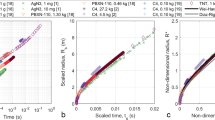Abstract
A key issue for explaining bursts and explosions of high explosives (HEs) under low-velocity mechanical impacts with registered time delays is the formation of local high-temperature regions. It is demonstrated by an example of HMX that the required temperatures should significantly exceed the HMX melting point and can be obtained only due to the work of viscosity forces in the liquid phase. In this case, however, it is necessary to ensure HE flow velocities greater than the primary impact velocities by several orders of magnitude. A mechanism of generation of such velocities is proposed: squeezing of the HE, which is heated on shear strains and plasticized, from the shear layer under the action of the pressure difference along the layer. Conditions of fast decomposition of the HE in the shear layer and conditions of an explosion of the surrounding HE are formulated.
Similar content being viewed by others
References
A. A. Selezenev, A. Yu. Aleinikov, and I. V. Brigins, “Molecular-Dynamic Simulation of Fracture of Explosive Molecules Under High-Velocity Impacts,” Khim. Fiz. 27 (3), 5–15 (2008).
V. M. Bel’skii, S. G. Ratnikova, and K. P. Novikov, “D–U Expressions and Equations of State with a Limiting Density for Unreacting Individual Explosives (HMX, RDX, PETN, Tetryl, TNT, and Nitromethane),” in Proc. XI Khariton Scientific Readings (VNIIEF, Sarov, 2009).
E. Yu. Orlova, N. A. Orlova, V. F. Zhilin, et al., HMXResistant Explosive (Nedra, Moscow, 1975) [in Russian].
Yu. B. Khariton, Detonation on Impact (Oborongiz, Moscow, 1940) [in Russian].
B. A. Khasainov, A. B. Attetkov, and A. A. Borisov, “Shock-Wave Initiation of Porous Energy Materials and Viscoplastic Model of Hot Spots,” Khim. Fiz. 15 (7), 53–124 (1996).
E. H. Walker, “Critical P2t Value Computations for Explosives Using the Shear Band Initiation Model,” BRL Memorandum Report No. 342 (January 1985).
E. H. Walker, “Derivation of the P2t Detonation Criterion,” in 8th Int. Symp. Detonation (1985), Vol.2.
F. R. Bowden and A. D. Yoffe, Initiation and Growth of Explosions in Liquids and Solids (Cambridge Univ. Press, Cambridge, UK 1952).
L. V. Dubnov, V. A. Sukhikh, and I. I. Tomashevich, “On the Nature of Mechanically Induced Hot Spots in Condensed Explosives,” Fiz. Goreniya Vzryva 7 (1), 147–149 (1971) [Combust., Expl., Shock Waves 7 (1), 123–125 (1971)].
Physical Values: Handbook, Ed. by I. S. Grigor’ev and E. Z. Meilikhova (Energoatomizdat, Moscow, 1991) [in Russian].
R. Menikoff and T. Sewell, “Constituent Properties of HMX Needed for Meso-Scale Simulations,” Report No. LA-UR-00-3804-rev (Los Alamos Nat. Lab., 2001).
V. A. Sukhikh and Yu. B. Khariton, “Bursts in Explosives in Short-Term Deformation,” in Problems of Chemical Kinetics, Combustion, and Explosions, Vol. 1: Theory of Explosives (Semenov Inst. of Chem. Phys., USSR Acad. of Sci., 1947) [in Russian].
V. N. Lashkov, O. L. Ignatov, D. A. Blinov, et al., “Submicroscopic and X-ray Structural Analysis of the State of HMX Crystals After Shock-Wave and Dynamic Loads,” in Shock Waves in Condensed Media: Proc. of the Int. Conf., Inst. of Exp. Phys. (Kiev, 2012).
L. D. Landau and E. M. Lifshits, Course of Theoretical Physics, Vol. 8: Electrodynamics of Continuous Media (GITTL, Moscow, 1953; Pergamon Press, 1960).
A. V. Dubovik, “Viscoelastic Model of Impact Ignition of Solid Explosives,” Fiz. Goreniya Vzryva 29 (2), 78–86 (1993) [Combust., Expl., Shock Waves 29 (2), 204–211 (1993)].
R. H. Guirguis, “Ignition Due to Macroscopic Shear,” in Shock Compression of Condensed Matter (1999).
V. G. Bugrov, A. Ya. Koshelev, and V. N. Lobanov, “HMX Initiation by Short-Term Shock Loads,” in Combustion, Explosion, and Shock Waves (Sarov, 1999) [in Russian].
A. V. Dubovik, “Thermal Instability of the Axial Deformation of a Plastic Layer and Estimation of the Critical Pressures of Impact Initiation of Solid HE (High Explosive),” Fiz. Goreniya Vzryva 16 (4), 103–109 (1980) [Combust., Expl., Shock Waves 16 (4), 447–452 (1980)].
Author information
Authors and Affiliations
Corresponding author
Additional information
Original Russian Text © V.S. Nefedov.
Published in Fizika Goreniya i Vzryva, Vol. 54, No. 5, pp. 65–75, September–October, 2018.
Rights and permissions
About this article
Cite this article
Nefedov, V.S. Initiation of Explosive Transformation of High Explosives under Low-Velocity Mechanical Impacts and Weak Shock Waves Due to Formation of Viscoplastic Flows. Combust Explos Shock Waves 54, 570–579 (2018). https://doi.org/10.1134/S001050821805009X
Received:
Revised:
Published:
Issue Date:
DOI: https://doi.org/10.1134/S001050821805009X




